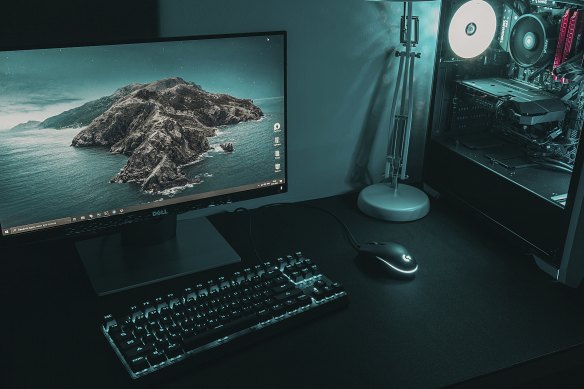Desktop Computer Ergonomics: Creating A Comfortable Workspace

In today’s digital age, many of us spend hours sitting at our desktop computers, whether for work, gaming, or simply browsing the internet. However, how often do we stop to consider the ergonomics of our workspace? Creating a comfortable and ergonomic setup for your desktop computer is essential for maintaining good posture, preventing discomfort and strain, and ultimately, improving productivity. In this article, we will explore the key principles of desktop computer ergonomics and provide practical tips for designing a workspace that promotes comfort and well-being. So, let’s dive into the world of ergonomic design and create a workspace that supports our health and productivity.
Related: Buy Best Desktops in Oman
Creating an Ergonomic Workspace: Key Considerations for Desktop Computer Users
Having a comfortable and ergonomic workspace is essential for desktop computer users. Not only does it help prevent discomfort and pain, but it also promotes productivity and overall well-being. When setting up your workspace, there are several key considerations to keep in mind.
First and foremost, adjust your chair to the correct height. Your feet should be flat on the floor, with your knees at a 90-degree angle. A chair with adjustable height and lumbar support is ideal for maintaining good posture and reducing strain on your back.
Next, position your monitor at eye level. This will help prevent neck and eye strain. Use a monitor stand or adjust the height of your desk to achieve the proper alignment. Additionally, ensure that the monitor is at an arm’s length distance from your eyes.
In addition to monitor placement, consider the position of your keyboard and mouse. Your keyboard should be at a height that allows your elbows to rest comfortably at your sides, with your arms bent at a 90-degree angle. Use a keyboard tray or adjustable desk to achieve the right height. Similarly, your mouse should be positioned close to your keyboard, at the same height, and within easy reach.
To further enhance your workspace ergonomics, incorporate proper lighting. Avoid glare on your screen by positioning your desk perpendicular to windows or using blinds or curtains to control natural light. If needed, use task lighting to illuminate your workspace adequately.
Finally, don’t forget to take regular breaks. Even with an ergonomic setup, sitting for long periods can still lead to discomfort. Take short breaks every hour to stretch and move around. Consider using a timer or a reminder app to help you stick to this routine.
Creating an ergonomic workspace is vital for desktop computer users. By following these key considerations, you can create a comfortable and productive environment that promotes overall well-being while minimizing the risk of discomfort and pain.
Optimizing Monitor Placement: Achieving the Ideal Eye Level and Distance
When it comes to optimizing your desktop computer setup, one crucial aspect to consider is the placement of your monitor. Achieving the ideal eye level and distance is essential for creating a comfortable workspace that promotes good posture and reduces eye strain. By following a few simple guidelines, you can ensure that your monitor is positioned in a way that maximizes your productivity and minimizes potential health issues.
Eye Level: Positioning your monitor at the correct eye level is crucial for maintaining proper posture and reducing strain on your neck and back. Ensure that the top of your screen is at or slightly below eye level. This will help you maintain a neutral head position and reduce the need to tilt your head up or down, which can lead to discomfort over time. Adjust the height of your monitor using a monitor stand, adjustable arm, or by stacking books or risers underneath it.
Distance: The distance between your eyes and the monitor also plays a significant role in reducing eye strain. Position your monitor at a comfortable distance, typically around 20 inches (50 centimeters) from your eyes. This distance allows you to read text and view images without squinting or straining your eyes. If you find yourself leaning forward or squinting to see the screen clearly, adjust the distance accordingly.
By optimizing the placement of your monitor, you can create a comfortable and ergonomic workspace that promotes productivity and reduces the risk of strain or discomfort. Remember to adjust the eye level and distance based on your individual needs and preferences. Experiment with different positions until you find what works best for you. Your body will thank you for taking the time to create a workspace that supports your well-being.
Choosing the Right Keyboard and Mouse: Enhancing Comfort and Reducing Strain
Why Choosing the Right Keyboard and Mouse is Crucial for a Comfortable Workspace?
When it comes to creating a comfortable workspace, paying attention to the ergonomics of your desktop computer setup is essential. One of the key elements that can greatly enhance your comfort and reduce strain is choosing the right keyboard and mouse. These often overlooked peripherals play a significant role in promoting good posture and minimizing the risk of repetitive strain injuries.
1. Keyboard:
- Consider an ergonomic keyboard design that promotes a more natural hand and wrist position.
- Look for adjustable keyboard heights or built-in wrist rests to reduce strain on your wrists.
- Opt for a keyboard with soft-touch keys to minimize noise and provide a comfortable typing experience.
2. Mouse:
- Choose an ergonomic mouse that fits comfortably in your hand and supports a neutral wrist position.
- Look for a mouse with customizable buttons and sensitivity settings to suit your individual needs.
- Consider a mouse with a trackball or touchpad if you experience discomfort from traditional mouse designs.
Remember, everyone’s comfort preferences may vary, so it’s important to try different options and find what works best for you. Investing in a keyboard and mouse that prioritize ergonomics can go a long way in creating a comfortable and productive workspace.
Ergonomic Accessories: Supporting Proper Posture and Minimizing Discomfort
In today’s digital age, many of us spend countless hours in front of our desktop computers, whether it’s for work or leisure. However, this prolonged sitting can take a toll on our bodies, leading to poor posture and discomfort. That’s where ergonomic accessories come in. These innovative tools are designed to support proper posture and minimize discomfort, allowing you to create a comfortable workspace that promotes productivity and overall well-being.
One essential ergonomic accessory is an adjustable monitor stand. Placing your monitor at eye level helps prevent neck strain and reduces the risk of developing headaches. Additionally, a keyboard tray or an ergonomic keyboard can improve your typing posture, reducing the strain on your wrists and fingers. Investing in an ergonomic mouse that fits comfortably in your hand can also help prevent repetitive strain injuries. Furthermore, a supportive ergonomic chair with adjustable height and lumbar support is crucial for maintaining proper spinal alignment and reducing lower back pain.
| Accessory | Benefit |
|---|---|
| Adjustable monitor stand | Prevents neck strain and reduces headaches |
| Keyboard tray/ergonomic keyboard | Improves typing posture and reduces wrist/finger strain |
| Ergonomic mouse | Prevents repetitive strain injuries |
| Supportive ergonomic chair | Maintains proper spinal alignment and reduces lower back pain |
By incorporating these ergonomic accessories into your desktop computer setup, you can create a comfortable workspace that supports proper posture and minimizes discomfort. Remember, taking care of your body while working or enjoying digital activities is essential for long-term health and productivity. So, invest in these ergonomic tools and make your desktop computer experience a truly comfortable one!
In Summary
In conclusion, creating a comfortable and ergonomic workspace for your desktop computer is essential for maintaining good posture, reducing strain on your body, and increasing overall productivity. By following the tips and guidelines provided in this article, you can make simple adjustments to your workstation that will have a significant impact on your overall well-being. Remember to take breaks, stretch, and listen to your body’s signals to ensure a healthy and comfortable work environment. With these small changes, you can transform your workspace into a place that promotes both physical and mental well-being. Here’s to a more comfortable and productive workday!



